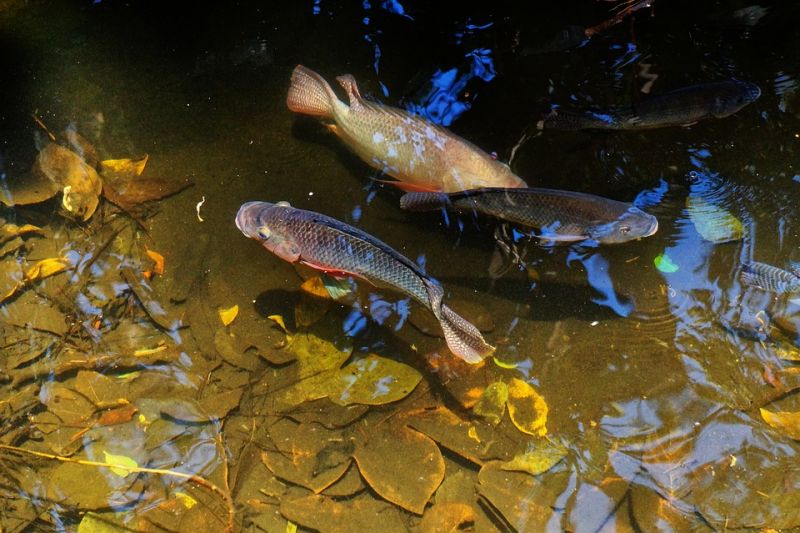How Climate Change May Affect Hawaiian Fishpond Aquaculture
Published on by Water Network Research, Official research team of The Water Network in Academic
Researchers have formed a collaborative partnership to understand the role of climate change in subtropical coastal estuarine environments within the context of aquaculture practices in Heʻeia Fishpond on Oʻahu.
For centuries, indigenous peoples of the Hawaiian Islands practiced sustainable aquaculture by building walled fishponds in coastal estuaries. Historical records estimate that, in the early 1900s, an extensive network of more than 450 fishponds across the Hawaiian Islands produced upward of 2 million pounds of fish annually and supported large thriving communities. Currently, worldwide aquaculture accounts for almost one-half of fish consumption.

Fish pond, representative image; Source; Pixabay
Researchers with the University of Hawaiʻi at Mānoa’s School of Ocean and Earth Science and Technology(SOEST) and Native Hawaiian fishpond stewards Paepae o Heʻeia formed a collaborative partnership to understand the role of climate change in subtropical coastal estuarine environments within the context of aquaculture practices in Heʻeia Fishpond on Oʻahu. Results published recently in PlosONE indicate that there is a relationship between two periods of high fish mortality at Heʻeia Fishpond and changes in the climate.
“Today, a majority of Hawaiian fishponds have been lost to coastal development and urbanization, but a growing community-based movement is working to restore and revitalize Hawaiian fishponds as a cornerstone to sustainable food fish production and resilient communities in an era of declining reef fish stocks,” said Hiʻilei Kawelo, Paepae o Heʻeia executive director.
However, these efforts are threatened by uncertainty over the effects of short- and long-term environmental changes, specifically storms and fluctuations in extreme seawater temperature that bring new stressors and exacerbate existing management challenges.
New understanding informs resource management
Throughout the 12-year study from 2004 to 2016, the partners measured winds, tides, temperature, water height, water movement and suspended material and phytoplankton in the water; and fish number, density and length. During this time, Hawaiʻi experienced periodic effects of El Niño such as slackening trade winds and warmer surface waters.
The partners correlated two periods of extremely high fish mortality at Heʻeia Fishpond with weakened trade winds in the week preceding each mortality event, as well as surface water temperatures 2 to 3 degrees Celsius warmer than normal. They posit that the lack of trade wind-driven surface water mixing enhanced surface heating of the fishpond, leading to stagnant conditions and stress on fish populations.
“Our results provide empirical evidence regarding El Niño effects on the coastal ocean, which can inform resource management efforts about the potential impact of climate variation on aquaculture production,” said Rosie Alegado, corresponding author of the study and assistant professor in the SOEST Department of Oceanography and University of Hawaiʻi Sea Grant College Program (Hawaiʻi Sea Grant).
As climate change is predicted to alter the intensity, frequency and geographic patterns of El Niño events, the partners developed three recommendations to reduce the impact of warming events on fishponds and limit the mortality of moi.
They recommended moving net pens closer to the mākāhā (sluice gates) with the highest flow rates of ocean water entering the fishpond which will decrease water temperatures and increase aeration in the pens. Additional steps include installing artificial aeration systems in the pens to limit stagnation and low oxygen, and implementing flexible harvest strategies at the onset of a warming event.
Using Hawaiian language newspapers to examine the past
To broaden understanding of Heʻeia Fishpond, the partners will next examine the impact of restoration on water chemistry in the fishpond over the past 10 years using a longtime series of data funded by Hawaiʻi Sea Grant.
Additionally, they are trying to determine how Native Hawaiians responded and adapted to these seasonal and episodic events. To do this, they have initiated investigation into the Hawaiian language newspapers to understand how these large scale climate patterns affected Hawaiʻi.
“Surprisingly, we have not seen evidence of historical fishkills, and we hypothesize that either fishponds were much less vulnerable to these events, or these events were much less severe, or that our kupuna (elder/ancestor) developed adaptive measures to combat these events,” said Alegado.
Read research article ' Large-scale climatic effects on traditional Hawaiian fishpond aquaculture ' HERE
Source: University of Hawai'i
Media
Taxonomy
- Aquaculture
- Aquaculture Systems
- Fisheries
- Ecosystem Management
- Climate Change
- Aquatic Ecologist
- Climate Change Adaptation
- Climate Change Resilience
- Aquafarming